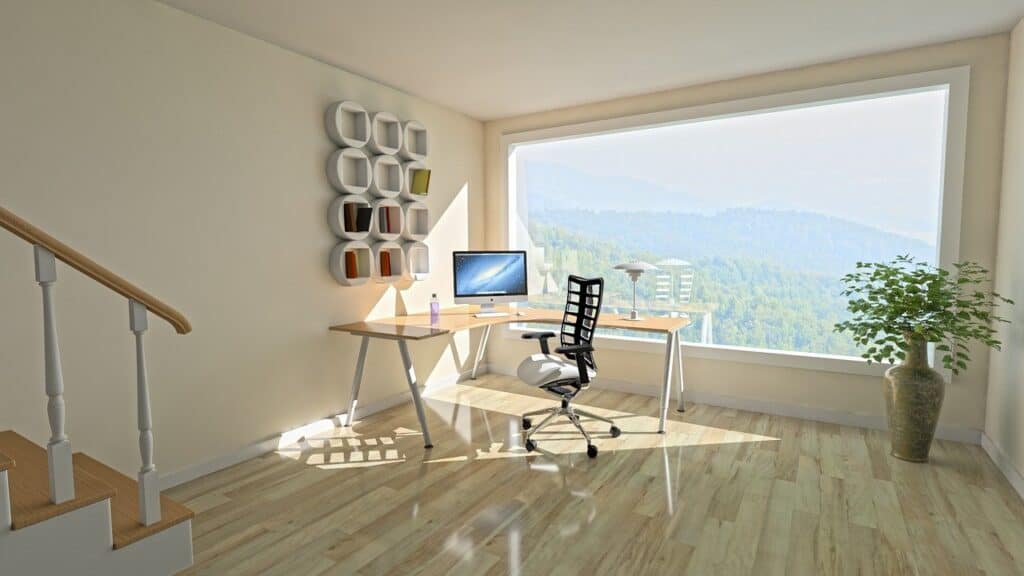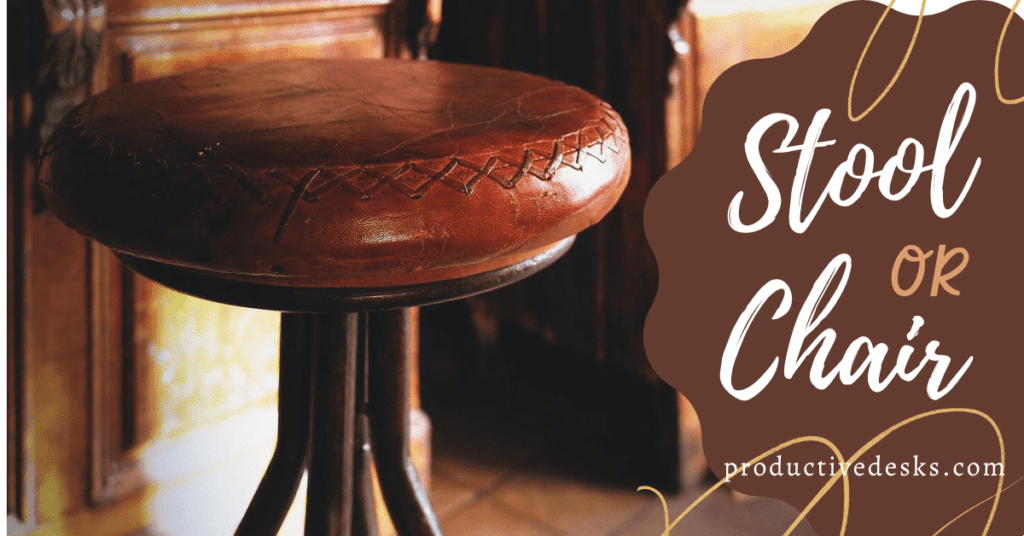This is the ultimate guide to understanding stools and chairs.
Do you know the difference between the two? Not so long ago, they were basically the same thing. Today, they are not only used for different tasks but have different ergonomic benefits as well.
Why stools and chairs matter, how they are different, how they are the same, and how they affect your body and your work.
If you want to make an informed decision about your seating needs in your home or office, read on!
- What Is A Stool: Pros / Cons
- What Is A Chair: Pros / Cons
- Stools Vs Chairs: Comparison Table
- Key Differences Between Stools And Chairs
- Are Stools or Chairs Right for You?
- Can You Use A Stool As A Desk Chair?
- What Is An Active Sitting Chair?
- Is A 3 Legged Stool More Stable Than A 4 Legged Stool?
- Final Thoughts – Stool vs Chair, What to Pick?
What Is A Stool?
A stool is a piece of furniture consisting of a single, usually cylindrical piece of furniture, which the user sits on.
“a seat usually without back or arms supported by three or four legs or by a central pedestal,” according to Merriam-webster.com.
A stool can be used for a variety of purposes. Some people use it as a footrest, while others use it to reach things from high shelves. Some people also use stools to create makeshift tables or desks when there are no available.
Pros:
The benefits of sitting on a stool are:
-It reduces the risk of back and neck pain, as well as other health problems.
-It improves your posture.
-Sitting on a stool is better for your circulation.
-It relieves pressure on your lower limbs, which can help prevent varicose veins and other circulatory problems.
Sitting on a stool can help you lose weight as you will have to use more energy than sitting in an office chair because the muscles in your legs are used more when standing up and sitting down.
Cons:
-Stools are usually high and can be difficult to sit on. They can also be uncomfortable, especially for short people.
-Moving them can be difficult sometimes as they typically don’t have armrests.
What Is A Chair?

A chair is a type of furniture that typically has four legs, two arms, and a seat. Chairs are often used to sit on and are used in many different contexts.
Chairs are the most common and basic furniture in a room. They are used for sitting, resting, and even sleeping.
Pros:
There are many advantages of sitting on a chair.
-The most obvious one is that it makes sitting more comfortable and relaxing.
-Ergonomic chairs come with lumbar support, which means they’ll help you avoid back pain.
-Most chairs have armrests, and sometimes headrests provide you with support for the head, neck, and arms. This way, you don’t have to strain too much by just relying on one side of your body.
-There’s space for you to make adjustments to suit your body needs.
Cons:
There are no disadvantages to chairs in general. Still, it’s important to be aware of the risks associated with sitting on them. It is pretty serious.
-Sitting for long periods of time on a chair can lead you to slouch LINK, which will lead to back pain, neck pain, and other health issues.
-Sitting on a chair also creates a higher risk for injury as the muscles in your legs become weaker from lack of use.
The critical problem with sitting is that it puts pressure on the body’s major organs and muscles, which restricts blood flow. This leads to a buildup of toxins in the body and makes it more difficult for the organs to function correctly.
The way you sit in a chair can affect your health. It can also affect your mood and productivity at work.
It is important to sit correctly in a chair so that you are not straining any of your back or spine muscles.
We invite you to check this article “How To Sit Properly At A Desk“, where we share a list of instructions to follow when sitting in a chair, from head to feet.
Stools Vs Chairs: Comparison Table
Stools | Chairs | |
Backrest | Usually no | Usually have backrests |
Armrest | No armrests | Usually have armrests |
Footrest | Optional | Optional |
Headrest | No | Can have a headrest |
Number Of Legs | 3 or 4 legs | 3 to 5 legs |
Height | Can be of any height, but it depends on how tall is the surface we are using. For example, if it is a countertop, the height ranges from 24 to 26 inches. | Can be of any height, but the height usually ranges from 17-19 inches. They can be height adjustable as well. |
Types | Stationary bar stools, bucket stools, distressed metal stools… | Executive office chairs, gaming chairs, leather office chairs, mesh office chairs … |
Key Differences Between Stools And Chairs

There are many differences between stools and chairs, and it is important to know the difference before you purchase one.
A chair is typically higher off the ground and has a back, while stools are often lower to the ground, without backs.
There are many differences between chairs and stools.
Chairs offer more support for the back and spine than stools do. They also allow for more movement because they have more space for your legs underneath them.
Chairs also offer more seating space than stools because they can be pulled up to tables or desks, whereas stools can’t be pushed under anything like that.
Stool seats are often made of wood or metal with a round seat surface, whereas chairs usually have padding on their seats that is covered in fabric of some kind.
A stool is smaller in size than a chair, while it is lighter in weight as well.
Are Stools Or Chairs Right for You?
When choosing between chairs and stools, it is crucial to take into consideration the following factors:
– The height of the stool or chair.
– The width of the stool or chair.
– The weight of the person using the stool or chair.
– Whether you need a seat with armrests.
– Whether you need a seat with armrests, backrest, and wheels.
The debate about what to sit on has been going on for a long time. Some people believe that sitting on a stool is better for your back, while others think that chairs are better because they provide more support.
Different people have different preferences when it comes to sitting down. It all depends on the person’s height and preference of what they feel comfortable with.
Can You Use A Stool As A Desk Chair?
A stool is not a desk chair. It is not designed to be used as one. The stool might be a good option for someone who has limited space and needs to have a sitting area, but it will never be as comfortable or ergonomic as a desk chair.
The person who designed the stool would never have considered it to be used as a desk chair because of its design and function.
Unless! It’s an active stool chair.
What Is An Active Sitting Chair?
An active sitting chair is a chair that helps to keep the user active while they are sitting.
This type of chair is designed to help users move their hips and torso as they sit so that they can get the benefits of being active without having to stand up and move around.
Active sitting chairs also help people with back pain by providing relief from pressure on their spine,

which often occurs when someone sits in a traditional office chair for a long time.
An active sitting chair is a great way for desk-bound people for long periods of time to get some movement throughout the day, which has been shown to reduce health risks and improve mood.
Click On The Image To View On Amazon
Active Vs. Traditional Office Chairs
A traditional office chair is not the best option for an office worker. It is not ergonomic, and it is not comfortable. Active chairs are much more ergonomic, and they provide better support for your back, neck, and shoulders.
Active chairs have adjustable features that allow them to move in different directions. They also have a built-in lumbar support system that provides comfort to the user. The back of the chair can be adjusted to help you maintain an upright posture while sitting on it.
>>> Related : Best Kneeling Chairs
Is A 3 Legged Stool More Stable Than A 4 Legged Stool?
The answer is yes.
A 3 legged stool is more stable than a 4 legged stool.
When you put weight on a 3 legged stool, it is more likely to stay upright because the weight of the person is distributed across three points.
The same goes for when you put weight on a 4 legged stool, but the weight distribution will be uneven and less stable.
Final Thoughts - Stool vs Chair, What to Pick?
We’ve seen that there are a lot of differences between chairs and stools. These differences include the height, the material, and even the price.
The height of a stool is usually lower than that of a chair. But this can be misleading because you may have to find an additional seat when you are sitting on it. The material is different too, as chairs are usually made of wood or metal while stools are typically made from plastic or steel.
Finally, there’s the price difference – chairs can cost more than stools because they often come with armrests and other features like wheels for mobility.
With all these differences in mind, it’s up to you to decide which one suits your needs better: a chair or a stool?
>>> Related : Why Office Chairs Are Expensive



